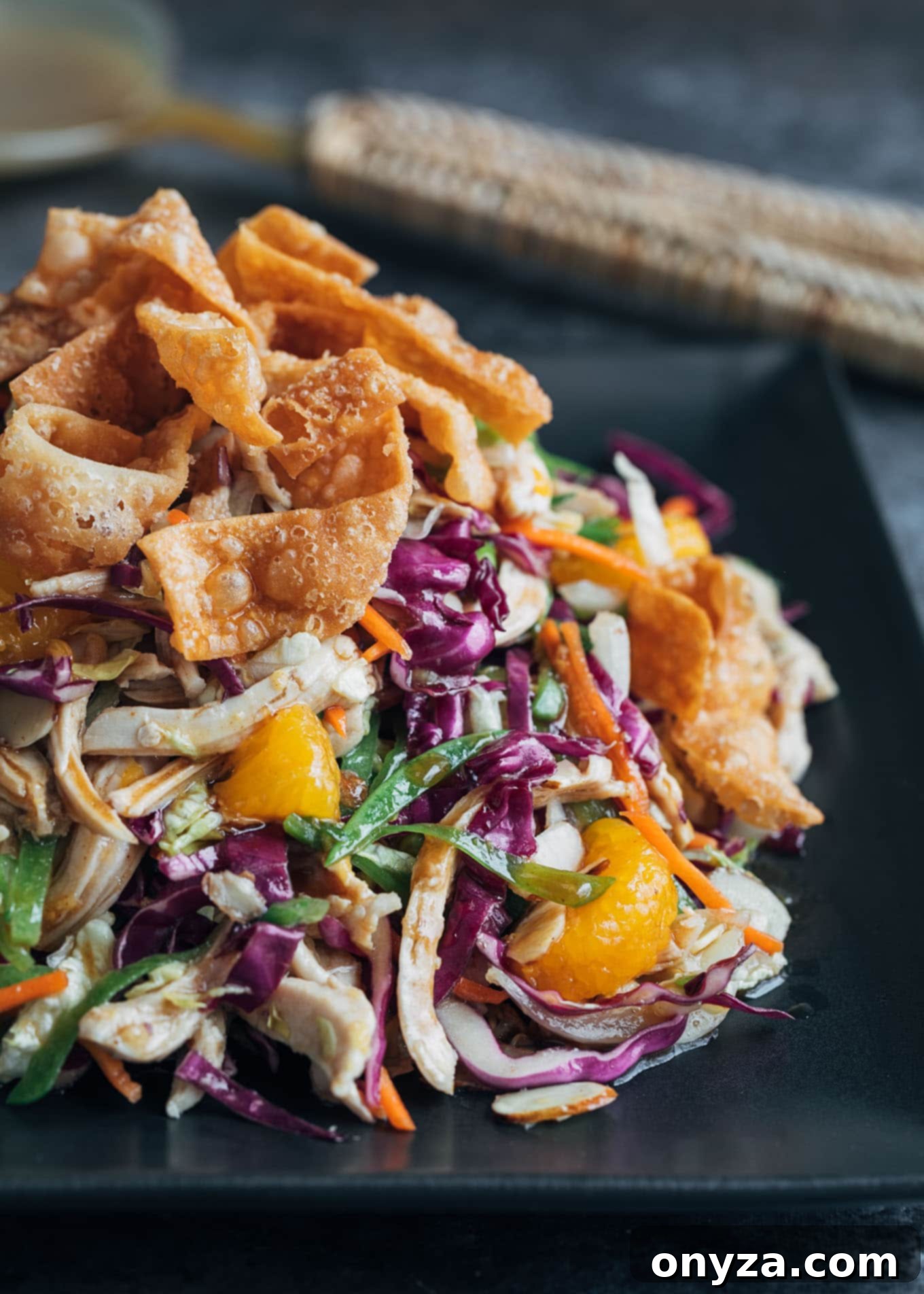The Mandarin Orange Chicken Salad is an undisputed star on American restaurant menus, renowned for its vibrant flavors, satisfying textures, and impressive presentation. Far from being an elusive restaurant-only treat, this delightful dish is surprisingly simple to recreate in your own kitchen. Our recipe artfully blends a generous array of crisp, fresh vegetables with succulent chicken, crunchy noodles, and a captivating plum-ginger vinaigrette, ensuring a gourmet experience that’s perfect for any lunch or light dinner.
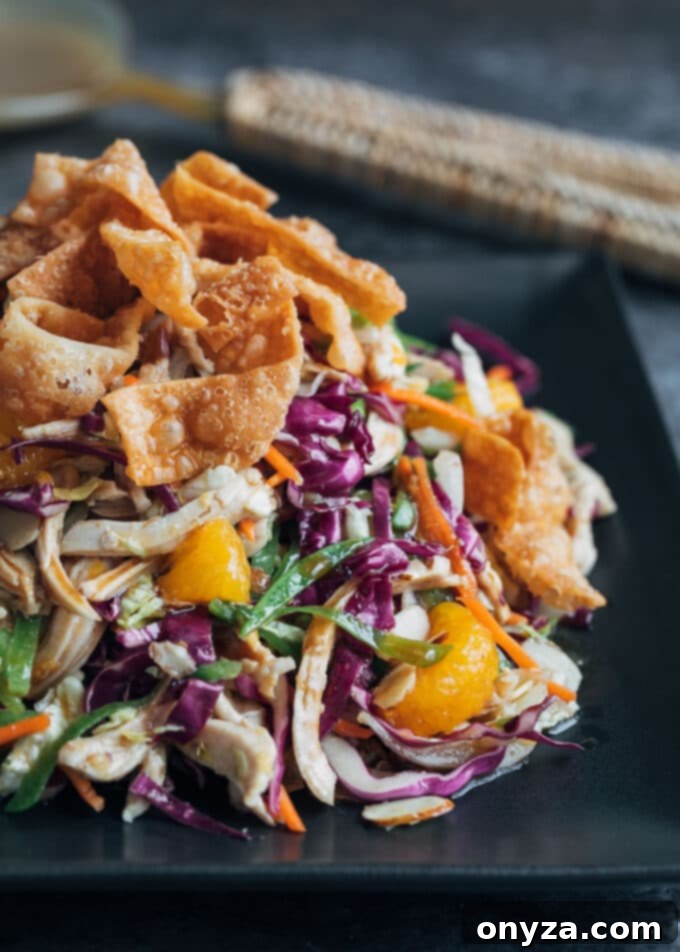
Many of us have experienced that moment in a bustling restaurant: a waiter glides past, carrying a towering, beautifully constructed chicken salad destined for another table. Your eyes widen, conversation briefly pauses, and a thought invariably crosses your mind, “Wow, look at that salad!” It’s a common reaction, a testament to the irresistible appeal of a well-crafted, visually stunning entree salad. The Mandarin Orange Chicken Salad, with its medley of colors and textures, consistently evokes this sense of culinary awe.
While often labeled as “Chinese” Chicken Salad, it’s important to note that this beloved dish is a distinctly American invention, not a traditional staple of authentic Chinese cuisine. Widely believed to have originated in California during the 1960s, this innovative take on a chopped salad quickly captured hearts and palates across the nation. Its popularity stems from a brilliant fusion of Asian-inspired flavors with familiar American salad concepts, creating something entirely unique and universally appealing.
The beauty of this Americanized classic lies in its adaptability. The recipe is broadly defined, allowing for a wide spectrum of ingredient variations, from the foundational vegetables to the nuanced dressing. This flexibility makes it an ideal candidate for home cooks eager to personalize their meals, ensuring that each rendition can be perfectly tailored to individual tastes and available ingredients. Inauthentic? Perhaps. Vaguely defined? Maybe. Delicious and endlessly customizable? Absolutely!
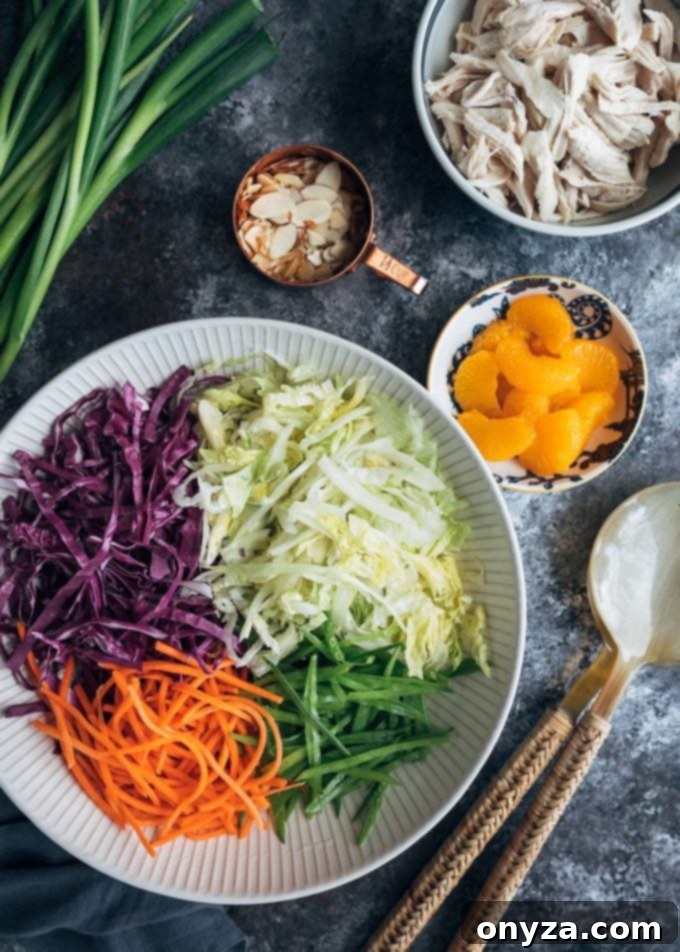
Crafting the Perfect Salad Base: A Symphony of Crunch
The hallmark of an exceptional Mandarin Orange Chicken Salad is an abundance of crisp, crunchy vegetables, providing a refreshing counterpoint to the savory chicken and sweet dressing. Our preferred combination includes thinly-sliced red cabbage, refreshing iceberg lettuce, delicate snow peas, vibrant shredded carrots, and aromatic scallions. This medley offers a fantastic balance of color, flavor, and, most importantly, texture, which is crucial for a satisfying salad.
Feel empowered to customize your salad base with any vegetables you particularly enjoy or have on hand. For a classic touch, green Napa cabbage is a superb choice; it can even replace the iceberg lettuce entirely if you desire an all-cabbage foundation, offering a slightly milder flavor and a tender-crisp texture. Bright red bell peppers add a pop of color and sweet crunch, while crisp bean sprouts can introduce another layer of refreshing crispness. Other excellent additions could include thinly sliced radishes for a peppery kick, or even finely chopped bok choy for an extra layer of green goodness.
To ensure a consistent and enjoyable texture throughout the salad, meticulous preparation of your vegetables is key. Thinly slicing or shredding all ingredients prevents large, awkward pieces and allows the flavors to meld beautifully. For this recipe, you’ll need approximately a quarter of a small head of both cabbage and lettuce. Using a sharp chef’s knife, cut thin slices along the long end of the cored wedges. As you slice, the pieces will naturally separate into perfect shreds. For even quicker preparation, especially for carrots, the shredding disk of your food processor is an invaluable tool, delivering uniform shreds with minimal effort. This attention to detail in preparation ensures every bite of your Mandarin Orange Chicken Salad is a delight.
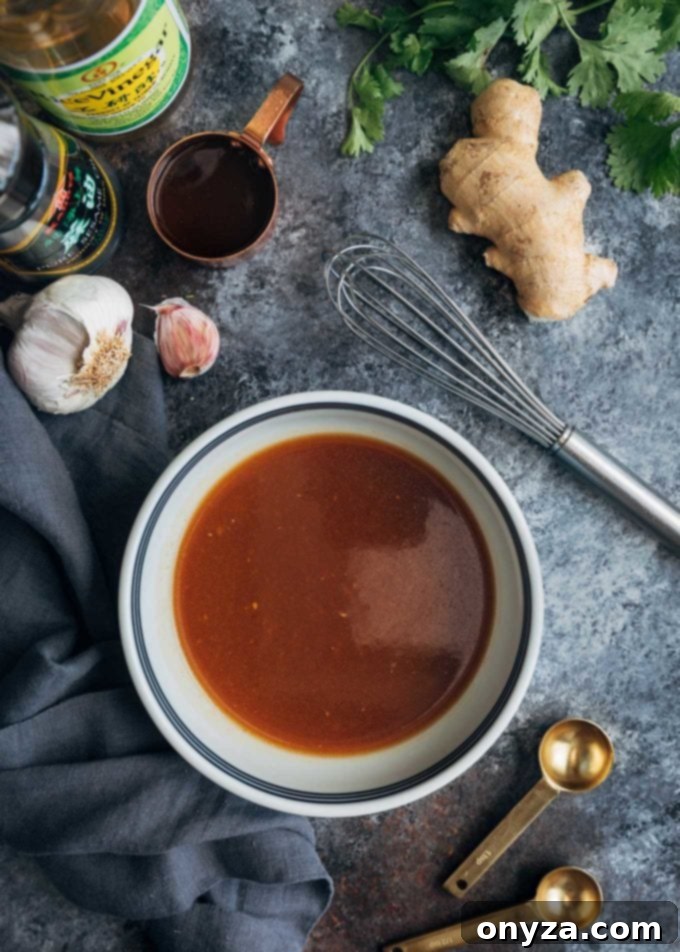
The Heart of the Flavor: Making the Plum-Ginger Vinaigrette
A truly unforgettable salad hinges on its dressing, and the plum-ginger vinaigrette in this recipe is nothing short of spectacular. It evokes the wonderfully balanced sweet and tangy notes of the popular Sesame Plum dressing found at the Cheesecake Factory, though it offers its own unique character. This homemade version boasts a brighter, fresher profile, making it a star component of the Mandarin Orange Chicken Salad.
The foundation of this exquisite vinaigrette is a rich, sweet-tangy plum sauce. This essential ingredient is readily available in the international aisle of most well-stocked grocery stores or at any Asian market. Whisking this flavorful base with freshly grated ginger—using a microplane is ideal for extracting maximum flavor—and minced garlic infuses the dressing with an aromatic warmth. Rice wine vinegar adds a crucial tang, while light soy sauce contributes savory depth. A touch of canola oil helps to emulsify the dressing and carry the flavors, and a mere hint of toasted sesame oil delivers a distinctive, nutty, and warmly aromatic finish that ties all the Asian-inspired elements together. This combination creates a dressing that is both complex and incredibly harmonious.
For those who appreciate a kick, a dash (or more, to your liking) of Sriracha can be whisked into the vinaigrette. We recommend starting with a small amount and gradually adding more until you achieve your desired level of heat. This allows you to perfectly customize the dressing’s spice profile. Whether you prefer it mild or with a fiery zing, this versatile vinaigrette is sure to elevate your salad experience. It’s a key element that makes this Mandarin Orange Chicken Salad truly special, tying together the diverse ingredients with its vibrant and flavorful embrace.
Heading to the market? Check out my Chinese-Inspired Cooking: Pantry Essentials guide to read more about these ingredients.
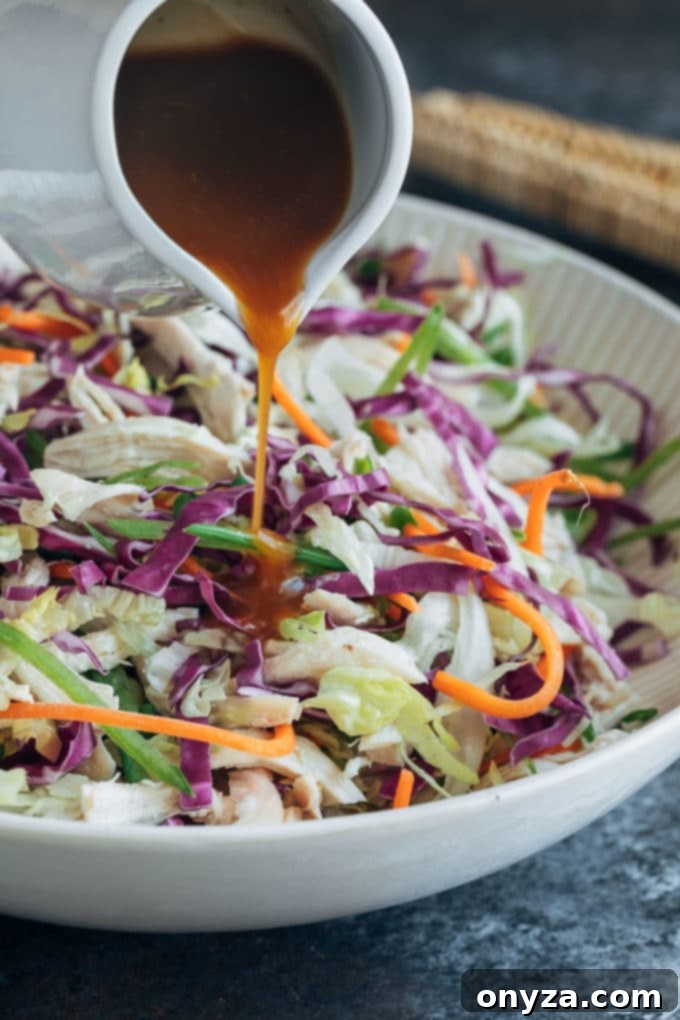
The Perfect Protein: Choosing and Preparing Your Chicken
The chicken component is central to this entree salad, providing a hearty and satisfying element. You’ll need cooked boneless, skinless chicken breasts, which can be either cubed or shredded, depending on your preference for texture. For a consistently juicy and tender result, poaching chicken breasts is highly recommended. This gentle cooking method locks in moisture, ensuring the chicken remains succulent and flavorful, perfectly complementing the crisp vegetables and vibrant dressing.
This recipe is also an excellent way to repurpose leftover roasted chicken or make quick work of a store-bought rotisserie chicken. Using pre-cooked chicken significantly cuts down on preparation time, making this salad an ideal choice for busy weeknights or meal prepping. If you opt for a store-bought rotisserie chicken, remember that some brands can be quite salty. Be mindful of this when seasoning your salad and adjusting the soy sauce in the vinaigrette to avoid over-salting.
For those who prefer to cook their chicken from scratch, poaching is a simple and rewarding technique. Place boneless, skinless chicken breasts in a pot, ensuring they are in a single layer if possible. Lightly season with salt, peppercorns, and aromatics like a garlic clove, a few sprigs of fresh herbs (such as thyme or parsley), and a dried bay leaf to infuse subtle flavor. Cover the chicken with water by about an inch, bring to a low boil, then reduce heat to a gentle simmer, cover, and cook until the internal temperature reaches 165°F (74°C) at its thickest point. This usually takes 5-14 minutes, depending on the size of the breasts. Once cooked, let the chicken rest before shredding or cubing. Both poached and roasted chicken can be prepared a few days in advance, stored covered in the refrigerator, making this Mandarin Orange Chicken Salad a fantastic option for efficient meal planning and hectic schedules.
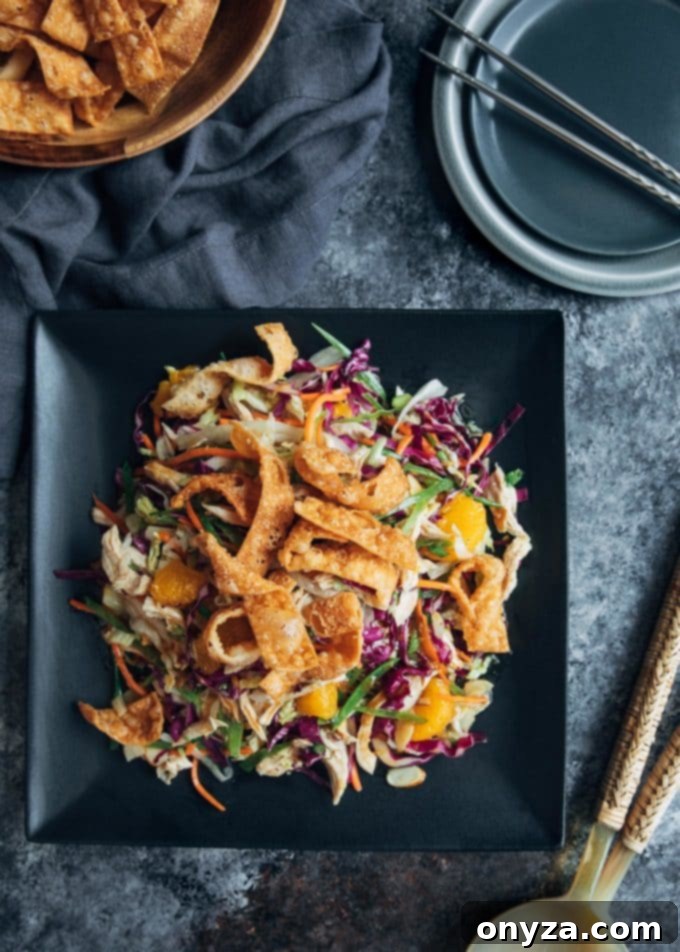
The Essential Add-Ins: Flavor, Texture, and Visual Appeal
No epic entree salad is complete without carefully chosen add-ins that elevate both flavor and texture. For our Mandarin Orange Chicken Salad, the star additions are juicy mandarin orange segments, crunchy sliced almonds, and irresistible crispy noodles. These components not only enhance the taste but also contribute significantly to the visual appeal and textural complexity of the dish.
We begin with the bright and sweet burst of mandarin orange segments. Whether you choose jarred segments for convenience or fresh mandarins when they’re in season, their citrusy sweetness and tender texture are a delightful contrast to the savory and crisp elements of the salad. During the holiday season, Satsumas are a personal favorite, renowned for their exceptional sweetness and juiciness. Incorporating these vibrant oranges often makes this salad a featured dish on our table during the late fall and early winter months, bringing a touch of seasonal cheer.
Want to read more about mandarin orange varieties? Check out this article from Harvest to Table.
Toasted sliced almonds introduce a nutty depth and an additional layer of delicate crunch, complementing the other textures without overpowering them. However, perhaps everyone’s favorite add-in is the crispy noodles, which deliver that signature satisfying crunch. You have two excellent options here: you can either prepare your own using a recipe for Fried Wonton Strips, which allows for ultimate freshness and control, or opt for the convenience of a store-bought bag of crunchy noodles, often labeled “Chow Mein Noodles,” found in most grocery stores.
When making your own crispy wonton strips, consider their presentation. For an elegant touch, mound a generous portion of the strips atop the salad just before serving. Guests can then break them into smaller pieces and mix them into their individual servings. If you prefer the crispy strips already integrated into the salad, simply break them into smaller pieces before tossing, or cut the wonton wrappers into thinner strips prior to frying. It’s important to gently add the mandarin oranges, almonds, and crispy noodles only after you’ve thoroughly tossed the salad with the vinaigrette. These delicate ingredients, particularly the fruit and nuts, should be handled as little as possible to maintain their integrity and ensure the most beautiful and appetizing plating.
Mandarin Orange Chicken Salad
Amanda Biddle
20
15
2
to 3 servings
Ingredients
Salad
- 2 cups shredded red cabbage
- 1 cup shredded iceberg lettuce
- ½ cup thinly-sliced snow peas
- ½ cup shredded carrots
- ⅓ cup thinly-sliced scallions
- 2-3 cups cooked shredded chicken breast (poached, roasted, or rotisserie)
- ¼ cup sliced almonds
- ¾ cup mandarin orange segments
Vinaigrette
- ¼ cup plum sauce
- ½ teaspoon grated ginger (using a microplane is recommended)
- 1 large garlic clove, minced
- 3 tablespoons rice wine vinegar
- 2 tablespoons light soy sauce
- 1 teaspoon toasted sesame oil
- 2 tablespoons canola or vegetable oil
- Kosher salt and ground white pepper, to taste
- ½ cup fried wonton strips (broken into pieces, if large)
Instructions
Assemble the Salad
- In a large bowl, gently toss together all of the salad ingredients, with the exception of the almonds and orange segments. These delicate components will be added just before serving to maintain their texture and appearance. Set the salad mixture aside while you prepare the vinaigrette.
Make the Vinaigrette and Serve
- In a separate medium bowl, whisk together the plum sauce, grated ginger, minced garlic, rice wine vinegar, soy sauce, and sesame oil until well combined. Gradually add the canola oil in a slow, steady stream, continuing to whisk vigorously until the dressing is fully emulsified and smooth. Season the vinaigrette to taste with kosher salt and ground white pepper, adjusting as needed to achieve your desired balance of flavors.
- Alternatively, for a quick and easy method, you can combine all of the vinaigrette ingredients in a mason jar. Secure the lid tightly and shake vigorously until all ingredients are thoroughly combined and emulsified.
- Pour enough of the prepared vinaigrette over the reserved salad mixture to lightly coat all the ingredients. Add the sliced almonds and mandarin orange segments, then gently toss to combine without bruising the delicate fruit. Mound the finished salad onto a large serving plate or individual plates. Top generously with the crispy wonton strips for an impressive presentation. You can offer any remaining dressing table-side for those who prefer an extra drizzle. Serve immediately to enjoy the freshest flavors and textures.
Notes
Variations:
- Replace the iceberg lettuce with shredded Napa cabbage for a slightly different texture and milder flavor.
- Swap the snow peas for ½ cup thinly-sliced red bell pepper or crisp bean sprouts to vary the crunch and color.
- For a spicy vinaigrette, whisk in Sriracha to taste, starting with a small amount and increasing gradually.
- Sprinkle the top of the salad with toasted sesame seeds just before serving for an extra layer of nutty flavor and visual appeal.
To Poach Chicken Breasts:
- Place 2 boneless, skinless chicken breasts in a pot, ensuring they are in a single layer if space allows. Sprinkle with ½ teaspoon kosher salt.
- Add about 1 teaspoon whole peppercorns and other aromatics such as a crushed garlic clove, a few sprigs of your favorite fresh herbs (like thyme or parsley), and a dried bay leaf to infuse flavor into the chicken.
- Add enough water to fully cover the chicken breasts by at least 1 inch. Bring the water to a low boil over medium heat, then immediately cover the pot and reduce the heat to maintain a gentle simmer.
- Cook until the chicken breasts register an internal temperature of 165 degrees F (74°C) at their thickest portion. Cooking time will vary, typically ranging from 5 to 14 minutes, depending on the size and thickness of the chicken breasts.
- Once cooked, remove the chicken from the poaching liquid and let it cool slightly before shredding or cubing. Store poached chicken breasts, covered or wrapped tightly in plastic wrap, in the refrigerator for up to 3-4 days, making them perfect for meal prep.
Nutrition Estimate
Calories:
707
kcal
|
Carbohydrates:
35
g
|
Protein:
45
g
|
Fat:
43
g
|
Saturated Fat:
7
g
|
Cholesterol:
119
mg
|
Sodium:
1028
mg
|
Potassium:
1114
mg
|
Fiber:
5
g
|
Sugar:
9
g
|
Vitamin A:
5385
IU
|
Vitamin C:
66.3
mg
|
Calcium:
113
mg
|
Iron:
4.6
mg
Nutrition information is automatically calculated, so should only be used as an approximation.
Please note that our recipes have been developed using the US Customary measurement system and have not been tested for high altitude/elevation cooking and baking.
Like this? Rate and comment below!
